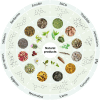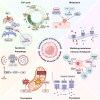Natural anti-cancer products: insights from herbal medicine
- PMID: 40490812
- PMCID: PMC12147394
- DOI: 10.1186/s13020-025-01124-y
Natural anti-cancer products: insights from herbal medicine
Abstract
Herbal medicine exhibits a broad spectrum of potent anti-cancer properties, including the enhancement of tumor immune responses, reversal of multidrug resistance, regulation of autophagy and ferroptosis, as well as anti-proliferative, pro-apoptotic, and anti-metastatic effects. This review systematically explores recent advances (primarily documented since 2019) in research on key anti-cancer compounds derived from herbal medicine, such as apigenin, artemisinin, berberine, curcumin, emodin, epigallocatechin gallate (EGCG), ginsenosides, icariin, resveratrol, silibinin, triptolide, and ursolic acid (UA). These studies were sourced from scientific databases, including PubMed, Web of Science, Medline, Scopus, and Clinical Trials. The review focuses on the significant role that these natural products play in modern oncology, exploring their efficacy, mechanisms of action, and the challenges and prospects of integrating them into conventional cancer therapies. Furthermore, it highlights cutting-edge approaches in cancer research, such as the utilization of gut microbiota, omics technologies, synthetic derivatives, and advanced drug delivery systems (DDS). This review underscores the potential of these natural products to advance the development of novel anti-cancer treatments and support contemporary medicine. Additionally, recent multi-omics findings reveal how these compounds reshape transcriptional and metabolic networks, further broadening their therapeutic scope. Many natural products exhibit synergy with first-line chemotherapies or targeted therapies, thereby enhancing treatment efficacy and reducing side effects. Advanced nano-formulations and antibody-drug conjugates have also substantially improved their bioavailability, making them promising candidates for future translational research.
Keywords: Cancer; Chinese medicinal herb; Chinese medicine; Herbal medicine; Natural product.
© 2025. The Author(s).
Conflict of interest statement
Declarations. Consent for publication: The manuscript is approved by all authors for publication. Competing interests: The authors declare no competing interests.
Figures



References
-
- Bray F, Laversanne M, Sung H, et al. Global cancer statistics 2022: GLOBOCAN estimates of incidence and mortality worldwide for 36 cancers in 185 countries. Cancer J Clin. 2024;74(3):229–63. - PubMed
Publication types
Grants and funding
- 0123/2022/A/Macao Science and Technology Development Fund
- 0008/2023/RIC/Macao Science and Technology Development Fund
- 001/2023/ALC/Macao Science and Technology Development Fund
- 0006/2020/AKP/Macao Science and Technology Development Fund
- 005/2023/SKL/Macao Science and Technology Development Fund
- lzujbky-2021-ey21/Outstanding Youth of the Fundamental Research Funds for the Central Universities
- SGDX2020110309420200/Shenzhen-Hong Kong-Macau S&T Program (Category C)
- MYRG-GRG2023-00198-ICMS/Research Fund of University of Macau
- SRG2022-00052-ICMS/Research Fund of University of Macau
- 17152116/Research Grants Committee Fund, Hong Kong
- 17121419/Research Grants Committee Fund, Hong Kong
- 18192141/Health and Medical Research Fund, Hong Kong
- 21222101/Health and Medical Research Fund, Hong Kong
- PRP/069/22FX/Innovation and Technology Fund, Hong Kong
LinkOut - more resources
Full Text Sources

